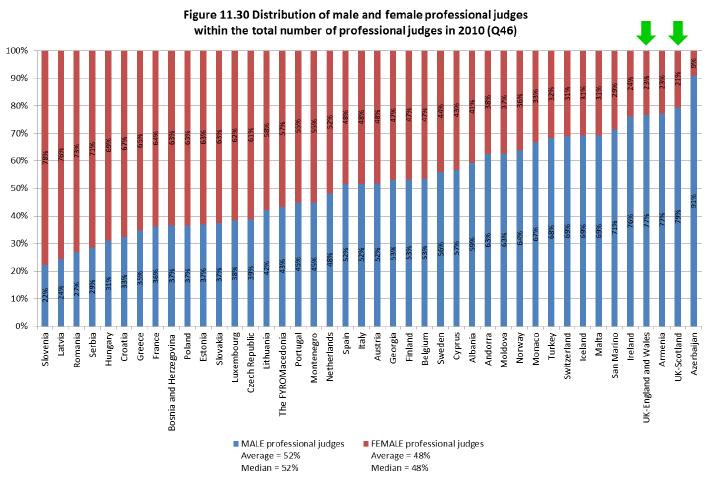Is Britain among Europe's worst for employing female judges?
"Only Azerbaijan has a lower proportion of women judges than Britain"
Independent, 20 September 2012
"UK among worst in Europe for employing female judges"
The Guardian, 20 September 2012
Fresh from winning the Eurovision Song Contest last year, today we learned that Azerbaijan holds another dubious honour: having the continent's most male-dominated judiciary.
According to the Independent, it is only the former Soviet state that outranks the UK for having the lowest proportion of professional female judges in Europe.
The Guardian reported a similar claim - but placed Armenia between Britain and Azerbaijan at the summit of this particular league table.
It's not hard to find where these claims are from, particularly for readers of the Guardian online who were given a direct link. The Council of Europe recently released a weighty 442 page report comparing European judiciaries.
Dig far enough into the report and you will find the figures quoted by both papers this morning:

The Council of Europe, through a questionnaire sent to the Ministry of Justice and 45 other European countries, found that only 23% of professional judges in England and Wales are women, and only 21% in Scotland. Armenia stands between the two on 23% with Azerbaijan further back on just 9%.
Conversely, Slovenia has the opposite gender imbalance, with 78% of all professional judges being female.
The figures are also made available by the Ministry of Justice, which publishes annual counts of male and female judges in their Justice and Court Statistics.
From this we can learn that, out of 3,575 judges in England and Wales, 2,768 were male and 807 were female as of 1 April this year. This confirms that 22.5% of professional judges in England and Wales are women.
This doesn't tell us about non-professional judges: the magistrates. Most people aged between 18 and 70 can become magistrates without any formal qualifications, so the process of becoming one is certainly a simpler matter than that for becoming a judge.
Specific figures for magistrates show that there are actually slightly more women (12,445) than men (11,822) and that since 2007 more women have been appointed to the Magistracy than men in any given year.
So the picture is actually somewhat more mixed when looking at the wider judiciary, and its possible the same could be the case for other countries in Europe.
The report also measures the size of the non-professional judiciary in many of the other countries, although this isn't broken down by gender. Nearly half of the other countries either don't have or don't have figures on non-professional judges. Among those that do are Germany with over 98,000 'lay' judges and Norway with 43,000.
We can't be sure without a gender breakdown, but the picture of the countries' entire judiciaries could be more complex than the figures for professionals imply.
Conclusion
The Guardian and Independent's figures are accurate, save for some ambiguity over Armenia's performance.
That said, the figures are only for professional judiciaries in Europe and don't account for magistrates and lay judges. The picture for the UK at least actually shows that more magistrates are women than men, and several other European countries have far more magistrates than they do professional judges.
Nevertheless, the figures will still be uncomfortable reading for those at home and abroad who want to see a more gender-balanced professional judiciary.
Disclosure: Baroness Julia Neuberger, one of Full Fact's Trustees, is currently Chair of the Advisory Panel on Judicial Diversity. Trustees set editorial policy but individual editorial decisions are made independently by Full Fact's staff.